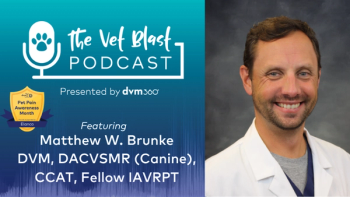
NSAIDS, anesthesia, and the kidney (Proceedings)
Nonsteroidal anti-inflammatory drugs (NSAIDs) are the most widely used analgesic drug class in human and veterinary medicine.
Nonsteroidal anti-inflammatory drugs (NSAIDs) are the most widely used analgesic drug class in human and veterinary medicine. NSAIDs are effective due to both peripheral and central mechanisms of analgesia. The widespread use of NSAIDs in human medicine has resulted in a large number of patients experiencing adverse effects including death. It has been estimated the 16,500 human deaths occur annually in the United States due to NSAID use. NSAID – associated deaths would account for the 15th leading cause of death in the U.S. if included separately on the National Vital Statistics report. Only a small number of patients (~19%) with serious gastrointestinal complications reported symptoms prior to presentation for the serious adverse effect. Therefore monitoring patients for adverse effects is a relatively insensitive method of preventing serious adverse effects associated with NSAID use. It is important to realize that severe complications also occur in veterinary medicine, including death, even with short treatment periods.
Mechanisms of action
The primary mechanism of action associated with NSAIDs is on the arachidonic acid pathway through the inhibition of the cyclooxygenase (COX) enzymes. However inhibition of lipoxygenase (LOX), nuclear factor κ-B (NF-κB), and bradykinin can also contribute to the effects of NSAIDS. At least two isoforms COX have been identified, COX-1 and COX-2. A variant of COX-1, termed COX-3, has also been identified in the cerebral cortex, but the biologic significance of COX-3 is still debated.
COX-1 is often referred to as constitutive as it contributes to routine physiologic processes and homeostasis. COX-1 is also up-regulated in inflammatory conditions and in the cerebral cortex as a component of the ascending pain pathways. COX-1 catalyzes the formation of prostaglandins that result in vasodilation, inflammation and pain, sensitization of nociceptors, fever, gastroprotective effects (increase mucous production, bicarbonate secretion, increase mucosal blood flow, inhibit acid secretion), and regulate renal blood flow in some species. COX-1 products are also converted to thromboxane in platelets that result in platelet aggregation and vasoconstriction.
COX-2 is often referred to as inducible as it is up-regulated in many inflammatory conditions and some neoplastic tissues. Prostaglandins produced by COX-2 result in vasodilation, inflammation and pain, sensitization of nociceptors, and fever. COX-2 is constitutively expressed in the renal vasculature of dogs and is primarily responsible for modulation of renal blood flow in dogs. COX-2 is up-regulated in healing GIT ulcers and is necessary for healing in the GIT. COX-2 products are also converted to prostacyclin which is primarily antagonistic to thromboxane. Prostacyclin results in vasodilation and inhibits platelet aggregation. Prostacyclin also sensitizes nociceptors. COX-2 is expressed in the dorsal horn of the spinal cord and is active in the propagation of the ascending pathways. COX-2 is up-regulated in certain neoplastic diseases such as transitional cell carcinoma and osteosarcoma. The mechanisms and reasons for the up-regulation are unclear, but may aid in the growth of blood vessels or as a result of an inflammatory response to the neoplastic growth. Feline neoplasms appear to express COX-2 to less of an extent than canine neoplasms therefore may be less likely to produce desired clinical effects. COX-2 is up-regulated in the uterus during late pregnancy and NSAID use has resulted in prolonged gestation. Maintenance of the patent ductus arteriosis is mediated by COX-2, therefore inhibition results in premature closure and altered fetal hemodynamics.
COX-3 has been identified in the cerebral cortex of dogs and humans. COX-3 is a splice variant of COX-1 with some researchers hypothesizing it has no biologic effect, but in vitro COX-3 catalyzes similar prostaglandins as COX-1. Researchers have shown that acetaminophen and dipyrone are potent inhibitors of COX-3 with minor effects on COX-1 and COX-2, leading to the hypothesis that the analgesic and antipyretic effects of acetaminophen and dipyrone are due to central effects and not due to peripheral anti-inflammatory effects.
Lipoxygenase catalyzes the formation of leukotrienes as a part of the arachidonic acid pathway. Leukotrienes are antagonistic to prostaglandins in many ways resulting in vasoconstriction and increased gastric acid secretion. Leukotrienes also result in bronchoconstriction and are pro-inflammatory leading to the activation, recruitment, migration, and adhesion of inflammatory cells in addition to increased production of inflammatory cytokines such as TNF-α and IL-1β. Tepoxalin is the only NSAID currently marketed that inhibits LOX, but the duration of inhibition is short; the IC50 is maintained for less the 6 hours. Zileuton (Zyflo) is a specific LOX inhibitor marketed for treatment of asthma in humans. Leukotriene antagonists such as montelukast (Singulair) and zafirlukast (Accolate) are also available for treatment of human asthma. The clinical usefulness of the zileuton and the LT antagonists for the treatment of pain have not been extensively studied in animals, but experimental models have demonstrated antinociceptive (analgesic) effects.
Lipoxins are modulators of inflammation produced from COX-2 products. Lipoxins are inhibitors of leukotrienes, natural killer cells, inhibit leukocyte migration, inhibit TNF-α and NF-κB, and inhibit adhesion molecules and production of interleukins. Aspirin is relatively unique among the NSAIDs as it acetylates COX-2 with lipoxin being preferentially produced, "Aspirin Triggered Lipoxin." COX-2 inhibitors co-administered with aspirin result in increased GIT toxicity than sole administration of either agent.
The simplistic classification of COX-1 is the "good" isoform and COX-2 is the "bad" isoform is an overly simplistic classification system. As described previously both isoforms are constitutively expressed and required for homeostasis and protective responses.
Adverse effects
Gastrointestinal
Gastrointestinal adverse effects are the most common adverse effects reported in dogs accounting for up to 64% of total adverse effects. Gastrointestinal adverse effects are associated with the use of any COX inhibitor regardless of whether it is a COX-2 selective or COX-1 sparing inhibitor. However the incidences of adverse effects decrease with COX-1 sparing inhibitors. Gastrointestinal adverse effects can range from gastritis and enteritis to ulceration and perforation. Unfortunately, clinical signs associated with the GIT (vomiting, diarrhea, anorexia, lethargy) are not always present prior to GI ulceration and perforation.
The GI adverse effects are primarily related to inhibition of COX-1 and resultant decreased gastroprotective effects as previously described. However, some researchers hypothesize that GI adverse effects may also be in part due to shunting of the arachidonic acid pathway away from the formation of prostaglandins by COX inhibitors to the formation of leukotrienes. Nonselective inhibitors of COX and LOX (dual inhibitors) have decreased GI adverse effects, despite the lack of a COX-1 sparing effect, as compared to nonselective COX inhibitors. Some NSAIDs also produce direct irritation of the GIT mucosa, but the primary GI adverse effects are due to COX-1 inhibition. Aspirin, as previously mentioned, is relatively unique among the NSAIDs as lipoxin, which produces GIT protecting effects, is a product of acetylated COX-2. The "tolerance" to aspirin induced GIT injury may be in part due to increased formation of lipoxin during chronic aspirin administration. Lipoxin formation is also the primary reason why a prolonged wash out period should be implemented when changing an NSAID from or to aspirin and the reason why aspirin and COX-2 inhibitors should not be administered concurrently.
In humans, GIT tract adverse events can be decreased by concurrent administration of misoprostol or proton pump inhibitors such as omeprazole. The currently recommended dosage of misoprostol (3 µg/kg PO q 12h) or omeprazole (1 mg/kg PO q 24h) may decrease the risk of NSAID associated gastrointestinal toxicity, but there is no evidence that either therapy increases the rate of gastrointestinal healing following NSAID toxicity in dogs.
Renal toxicity
Renal adverse effects account for ~21% of the reported adverse effects in dogs. The incidence of renal toxicity, particularly in cats, appears to be increasing with increasing NSAID usage. In dogs, COX-2 is constitutively expressed in the renal vasculature and mediates renal vasodilation, and is up-regulated, maintaining renal blood flow during episodes of renal hypotension. In other species COX-1 is constitutively expressed in the renal vasculature, whereas COX-2 is up-regulated during hypotensive episodes and is important in the maintenance of renal blood flow. The expression of COX-1 and COX-2 in the feline renal vasculature has not been described.
The incidence of renal adverse effects is increased during conditions of renal hypotension such as anesthesia, hypovolemia, systemic hypotension, cardiovascular disease, shock, or concurrent administration of nephrotoxic drugs. Use of COX-2 selective NSAIDS does not result in a decrease in renal adverse effects due to the constitutive nature of COX-2 in canine renal vasculature. The use of NSAIDs in chronic renal failure is generally not recommended, but has been used occasionally. Strong client warnings are recommended with the inclusion of a signed consent form for cases involving the use of NSAIDs and chronic renal disease.
Hepatic toxicity
Hepatic toxicity is the third most common adverse effect reported for NSAIDs accounting for approximately 14% of reported cases in dogs. Hepatic toxicity can be dose-dependent (i.e. over dose) or idiosyncratic (non dose-dependent). Idiosyncratic toxicity often occurs during the first few days to weeks of treatment. Currently no data are available to ascertain whether any of the currently marketed NSAIDs are more prone to idiosyncratic toxicity, as it has been reported for all of the veterinary licensed NSAIDs. Hepatic dysfunction is not an absolute contraindication to the use of NSAIDs, but dysfunction may result in decreased metabolism leading to toxicity.
Inhibition of platelet aggregation
Inhibition of platelet aggregation is an adverse effect associated with COX-1 selective NSAIDs such as aspirin, ketoprofen and flunixin in dogs. Of the NSAIDs, aspirin is the most likely drug to result in abnormal bleeding as it irreversibly inhibits thromboxane synthetase, essentially irreversible inactivating the platelet. Other COX-1 selective NSAIDs produce a reversible inhibition, meaning once the drug concentrations decrease, platelet function returns to normal. Aspirin has been investigated as an anticoagulant in cats prone to thrombus formation, but the clinical results have been disappointing.
Concurrent drug use
In general the concurrent use of NSAIDs and corticosteroids should be avoided due to the increased potential of GIT adverse effects. The effects of diuretics and angiotensin converting enzyme inhibitors (ACE inhibitors), such as furosemide and enalapril, are decreased when concurrent administered with NSAIDs. Combining NSAIDs with other analgesic such as opioids, tramadol, gabapentin, and amantadine result in additive to synergistic analgesic effects and more effective pain control.
NSAID screening and monitoring
Current recommendations for screening patients prior to NSAID therapy include a detailed history and physical exam. Patients that are expected to receive long-term NSAIDs typically are screened with a CBC, chemistry panel (including renal and hepatic parameters), and urinalysis. Rechecks are often recommended in the first week or two and then every 3-12 months depending on the animal's age, frequency of NSAID administration, and concurrent diseases and medications.
Conclusions
In general NSAIDs are well tolerated by veterinary patients, however serious adverse effects including death occur on an infrequent, but regular basis. NSAIDs are not absolutely safe drugs, but the introduction of newer NSAIDs has decreased the incidence of adverse drug effects. Owners should always be warned of potential adverse effects including gastrointestinal, renal, and hepatic injury, and even death.
Online resources
FDA brochure available online:
What Veterinarians Should Tell Clients About Pain Control and Their Pets available online at:
Newsletter
From exam room tips to practice management insights, get trusted veterinary news delivered straight to your inbox—subscribe to dvm360.






